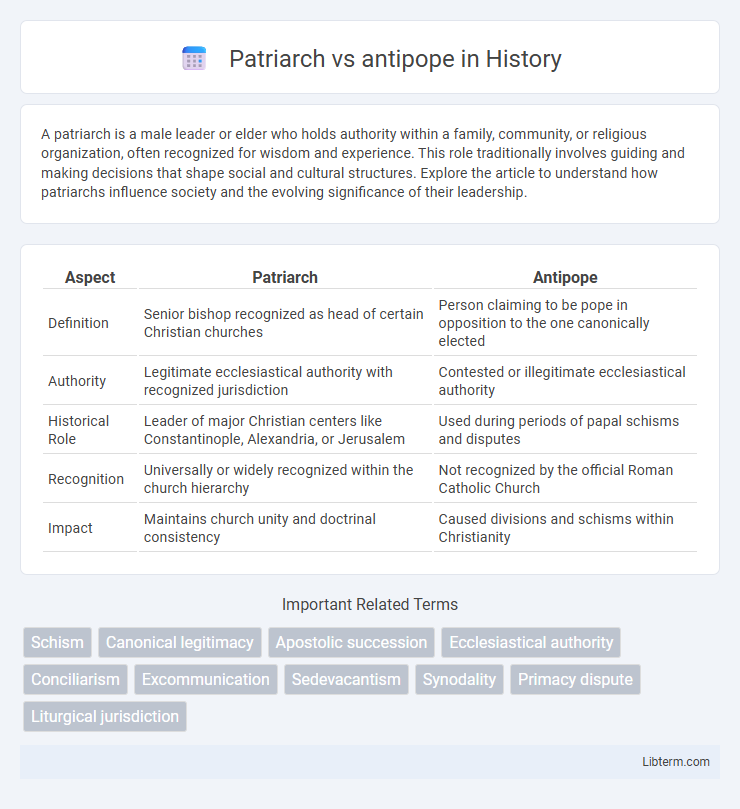A patriarch is a male leader or elder who holds authority within a family, community, or religious organization, often recognized for wisdom and experience. This role traditionally involves guiding and making decisions that shape social and cultural structures. Explore the article to understand how patriarchs influence society and the evolving significance of their leadership.
Table of Comparison
| Aspect | Patriarch | Antipope |
|---|---|---|
| Definition | Senior bishop recognized as head of certain Christian churches | Person claiming to be pope in opposition to the one canonically elected |
| Authority | Legitimate ecclesiastical authority with recognized jurisdiction | Contested or illegitimate ecclesiastical authority |
| Historical Role | Leader of major Christian centers like Constantinople, Alexandria, or Jerusalem | Used during periods of papal schisms and disputes |
| Recognition | Universally or widely recognized within the church hierarchy | Not recognized by the official Roman Catholic Church |
| Impact | Maintains church unity and doctrinal consistency | Caused divisions and schisms within Christianity |
Definition of Patriarch and Antipope
A patriarch is a principal bishop in certain Christian churches, recognized as the highest-ranking authority within an autonomous or autocephalous church, often overseeing multiple dioceses or regions. An antipope is an individual who makes a contested claim to be the pope, usually opposing the legitimately elected pope, and is not recognized as the legitimate leader of the Roman Catholic Church. The distinction centers on ecclesiastical legitimacy and authority within the Christian hierarchy, with patriarchs holding recognized episcopal authority and antipopes representing rival, unauthorized claims to the papal office.
Historical Origins of the Patriarchate
The Historical Origins of the Patriarchate trace back to the early Christian Church when key bishops in major cities like Rome, Constantinople, Alexandria, Antioch, and Jerusalem gained prominence as Patriarchs, symbolizing ecclesiastical authority and regional leadership. This hierarchical structure emerged during the first few centuries, especially after the Council of Nicaea in 325 AD, which formalized distinctions between local churches and elevated the status of these five sees. Conflicts arose when individuals claimed papal or patriarchal authority without official recognition, leading to the concept of Antipopes who challenged the legitimacy of established Patriarchs.
Emergence of the Antipope in Church History
Emergence of the antipope in church history traces back to periods of intense political and theological conflict, where rival factions claimed legitimate papal authority. Patriarchs, as recognized leaders of major Eastern Christian centers, often opposed or influenced these claimants, exacerbating divisions within the Christian world. The phenomenon highlights the struggle for ecclesiastical control during times of schism, reflecting the complex interplay between religious and imperial powers.
Key Differences: Patriarch vs Antipope
The key differences between a patriarch and an antipope lie in their legitimacy and ecclesiastical authority; a patriarch is a recognized senior bishop leading an autocephalous or autonomous church within Eastern Orthodoxy or Oriental Orthodoxy, while an antipope is a claimant to the papacy not acknowledged by the Roman Catholic Church. Patriarchs hold canonical jurisdiction over specific geographic or cultural church territories, often with centuries-old traditions, whereas antipopes emerge during periods of schism or conflict, challenging the rightful pope's authority. The role of patriarch reflects established hierarchical structure, whereas an antipope represents contested or illegitimate papal claims within Catholic history.
Notable Patriarchs Throughout History
Notable patriarchs throughout history include figures such as Patriarch Photius I of Constantinople, whose influence shaped Byzantine theology and ecclesiastical politics, and Patriarch Ignatius of Antioch, revered for his early Christian writings and martyrdom. In contrast, antipopes like Clement VII and Benedict XIII emerged during papal schisms, challenging the legitimacy of reigning popes and creating ecclesiastical divisions. The roles of patriarchs often encompassed official leadership of major Christian centers, while antipopes represented rival claimants seeking recognition in contested periods.
Infamous Antipopes and Their Impact
Infamous antipopes such as Clement VII and Benedict XIII challenged the authority of legitimate patriarchs during the Western Schism, fracturing the unity of the Catholic Church and inciting political turmoil across Europe. These antipopes wielded significant influence by establishing rival papal courts in Avignon and Rome, which undermined ecclesiastical hierarchy and complicated the allegiance of clergy and monarchs. The long-lasting impact of their disputed claims diminished the perceived legitimacy of patriarchal authority and prompted reforms aimed at strengthening papal succession and church unity.
Causes of Schism: How Antipopes Arise
Antipopes arise primarily due to disputes over papal succession, often fueled by political interference and factional conflicts within the Church and secular realms. Patriarchs, as leaders of major Eastern Christian sees, sometimes supported rival claimants to the papacy, exacerbating divisions and leading to schisms. These disputes highlight the complex interplay between religious authority, imperial influence, and regional loyalties that fostered the emergence of antipopes during periods of ecclesiastical instability.
The Role of Authority and Legitimacy
The role of authority in the distinction between patriarchs and antipopes centers on ecclesiastical legitimacy rooted in recognized church hierarchy and canonical election procedures. Patriarchs possess established jurisdictional authority within their respective churches, validated by longstanding tradition and papal or synodal endorsement. Antipopes emerge as rival claimants to the papacy, often lacking canonical legitimacy and causing schisms by challenging the rightful pontiff's authority.
Consequences of Patriarch-Antipope Conflicts
Conflicts between patriarchs and antipopes historically led to significant schisms within the Christian Church, fracturing ecclesiastical unity and diminishing the authority of the papacy. These disputes often triggered prolonged periods of political instability, as secular rulers aligned with rival claimants, further complicating church-state relations. The long-term consequences included weakened centralized control over doctrine, splintered Christian communities, and challenges to the legitimacy of ecclesiastical leadership.
Legacy and Modern Relevance
Patriarchs hold significant legacy as recognized spiritual leaders in major Christian traditions like Eastern Orthodoxy, preserving doctrinal authority and historical continuity since antiquity. Antipopes, historically arising during schisms, represent contested claims to the papal office, often viewed as sources of division and ecclesiastical conflict. Modern relevance of patriarchs centers on their role in interfaith dialogue and cultural identity, whereas antipopes mainly serve as historical reminders of Church disputes impacting institutional unity.
Patriarch Infographic

 libterm.com
libterm.com